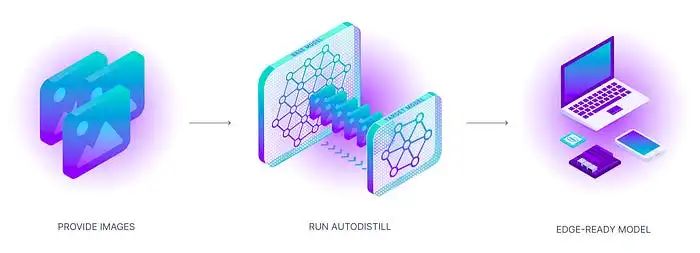Is the era of object detection and labeling over?
In the rapidly evolving field of machine learning, one aspect has remained constant: the tedious and time-consuming task of data annotation. Whether used for image classification, object detection, or semantic segmentation, human-labeled datasets have long been the foundation of supervised learning.

However, that may soon change thanks to an innovative tool called AutoDistill.
The Github code link is as follows: https://github.com/autodistill/autodistill?source=post_page.
AutoDistill is a groundbreaking open source project aiming to revolutionize the process of supervised learning. The tool leverages large, slower base models to train smaller, faster supervised models, enabling users to go directly from unlabeled images to custom models running at the edge for inference without human intervention.

How does AutoDistill work?
The process of using AutoDistill is as simple and powerful as its functionality. Unlabeled data is first fed into the base model. The base model then uses the ontology to annotate the data set to train the target model. The output is a distilled model that performs a specific task.

Let us explain these components:
- Base Model: The base model is a large base model, Such as Grounding DINO. These models are often multimodal and can perform many tasks, although they are often large, slow, and expensive.
- Ontology: Ontology defines how to prompt the base model, describe the content of the data set, and what the target model will predict.
- Dataset: This is a set of automatically labeled data that can be used to train the target model. The dataset is generated by the base model using unlabeled input data and ontologies.
- Target Model: The target model is a supervised model that consumes a dataset and outputs a distilled model for deployment. Examples of target models might include YOLO, DETR, etc.
- Distillation Model: This is the final output of the AutoDistill process. It is a set of weights fine-tuned for your task and can be used to obtain predictions.
#AutoDistill’s ease of use is truly impressive: pass unlabeled input data to a base model such as Grounding DINO, and then use an ontology to label the dataset to train the target model, and finally get a task-specific model that has been accelerated distillation and fine-tuning
Please click the following link to watch the video to understand the actual operation process: https://youtu.be/gKTYMfwPo4M
The Impact of AutoDistill
Computer vision has always had a major obstacle, that is, labeling requires a lot of manual labor. AutoDistill has taken an important step towards solving this problem. The tool's underlying model has great potential to autonomously create data sets for many common use cases, and to extend its utility through creative prompts and few-shot learning.
However, despite these The progress is impressive, but it doesn’t mean labeled data is no longer needed. As underlying models continue to improve, they will increasingly be able to replace or supplement humans in the annotation process. But at present, manual annotation is still necessary to some extent.
The Future of Object Detection
As researchers continue to improve the accuracy and efficiency of object detection algorithms, we expect to see them used in a wider range of real-world applications field. For example, real-time object detection is a key research area with numerous applications in areas such as autonomous driving, surveillance systems, and sports analytics.
Object detection in videos is a challenging research area that involves tracking objects across multiple frames and dealing with motion blur. Developments in these areas will bring new possibilities for object detection, while also demonstrating the potential of tools such as AutoDistill
Conclusion
AutoDistill represents a breakthrough in the field of machine learning An exciting development. By using base models to train supervised models, this tool paves the way for a future where the tedious task of data annotation is no longer a bottleneck in developing and deploying machine learning models.
The above is the detailed content of Is the era of object detection and labeling over?. For more information, please follow other related articles on the PHP Chinese website!

Hot AI Tools

Undresser.AI Undress
AI-powered app for creating realistic nude photos

AI Clothes Remover
Online AI tool for removing clothes from photos.

Undress AI Tool
Undress images for free

Clothoff.io
AI clothes remover

AI Hentai Generator
Generate AI Hentai for free.

Hot Article

Hot Tools

Notepad++7.3.1
Easy-to-use and free code editor

SublimeText3 Chinese version
Chinese version, very easy to use

Zend Studio 13.0.1
Powerful PHP integrated development environment

Dreamweaver CS6
Visual web development tools

SublimeText3 Mac version
God-level code editing software (SublimeText3)

Hot Topics
 1378
1378
 52
52
 This article will take you to understand SHAP: model explanation for machine learning
Jun 01, 2024 am 10:58 AM
This article will take you to understand SHAP: model explanation for machine learning
Jun 01, 2024 am 10:58 AM
In the fields of machine learning and data science, model interpretability has always been a focus of researchers and practitioners. With the widespread application of complex models such as deep learning and ensemble methods, understanding the model's decision-making process has become particularly important. Explainable AI|XAI helps build trust and confidence in machine learning models by increasing the transparency of the model. Improving model transparency can be achieved through methods such as the widespread use of multiple complex models, as well as the decision-making processes used to explain the models. These methods include feature importance analysis, model prediction interval estimation, local interpretability algorithms, etc. Feature importance analysis can explain the decision-making process of a model by evaluating the degree of influence of the model on the input features. Model prediction interval estimate
 Identify overfitting and underfitting through learning curves
Apr 29, 2024 pm 06:50 PM
Identify overfitting and underfitting through learning curves
Apr 29, 2024 pm 06:50 PM
This article will introduce how to effectively identify overfitting and underfitting in machine learning models through learning curves. Underfitting and overfitting 1. Overfitting If a model is overtrained on the data so that it learns noise from it, then the model is said to be overfitting. An overfitted model learns every example so perfectly that it will misclassify an unseen/new example. For an overfitted model, we will get a perfect/near-perfect training set score and a terrible validation set/test score. Slightly modified: "Cause of overfitting: Use a complex model to solve a simple problem and extract noise from the data. Because a small data set as a training set may not represent the correct representation of all data." 2. Underfitting Heru
 Transparent! An in-depth analysis of the principles of major machine learning models!
Apr 12, 2024 pm 05:55 PM
Transparent! An in-depth analysis of the principles of major machine learning models!
Apr 12, 2024 pm 05:55 PM
In layman’s terms, a machine learning model is a mathematical function that maps input data to a predicted output. More specifically, a machine learning model is a mathematical function that adjusts model parameters by learning from training data to minimize the error between the predicted output and the true label. There are many models in machine learning, such as logistic regression models, decision tree models, support vector machine models, etc. Each model has its applicable data types and problem types. At the same time, there are many commonalities between different models, or there is a hidden path for model evolution. Taking the connectionist perceptron as an example, by increasing the number of hidden layers of the perceptron, we can transform it into a deep neural network. If a kernel function is added to the perceptron, it can be converted into an SVM. this one
 The evolution of artificial intelligence in space exploration and human settlement engineering
Apr 29, 2024 pm 03:25 PM
The evolution of artificial intelligence in space exploration and human settlement engineering
Apr 29, 2024 pm 03:25 PM
In the 1950s, artificial intelligence (AI) was born. That's when researchers discovered that machines could perform human-like tasks, such as thinking. Later, in the 1960s, the U.S. Department of Defense funded artificial intelligence and established laboratories for further development. Researchers are finding applications for artificial intelligence in many areas, such as space exploration and survival in extreme environments. Space exploration is the study of the universe, which covers the entire universe beyond the earth. Space is classified as an extreme environment because its conditions are different from those on Earth. To survive in space, many factors must be considered and precautions must be taken. Scientists and researchers believe that exploring space and understanding the current state of everything can help understand how the universe works and prepare for potential environmental crises
 Implementing Machine Learning Algorithms in C++: Common Challenges and Solutions
Jun 03, 2024 pm 01:25 PM
Implementing Machine Learning Algorithms in C++: Common Challenges and Solutions
Jun 03, 2024 pm 01:25 PM
Common challenges faced by machine learning algorithms in C++ include memory management, multi-threading, performance optimization, and maintainability. Solutions include using smart pointers, modern threading libraries, SIMD instructions and third-party libraries, as well as following coding style guidelines and using automation tools. Practical cases show how to use the Eigen library to implement linear regression algorithms, effectively manage memory and use high-performance matrix operations.
 Multi-grid redundant bounding box annotation for accurate object detection
Jun 01, 2024 pm 09:46 PM
Multi-grid redundant bounding box annotation for accurate object detection
Jun 01, 2024 pm 09:46 PM
1. Introduction Currently, the leading object detectors are two-stage or single-stage networks based on the repurposed backbone classifier network of deep CNN. YOLOv3 is one such well-known state-of-the-art single-stage detector that receives an input image and divides it into an equal-sized grid matrix. Grid cells with target centers are responsible for detecting specific targets. What I’m sharing today is a new mathematical method that allocates multiple grids to each target to achieve accurate tight-fit bounding box prediction. The researchers also proposed an effective offline copy-paste data enhancement for target detection. The newly proposed method significantly outperforms some current state-of-the-art object detectors and promises better performance. 2. The background target detection network is designed to use
 Explainable AI: Explaining complex AI/ML models
Jun 03, 2024 pm 10:08 PM
Explainable AI: Explaining complex AI/ML models
Jun 03, 2024 pm 10:08 PM
Translator | Reviewed by Li Rui | Chonglou Artificial intelligence (AI) and machine learning (ML) models are becoming increasingly complex today, and the output produced by these models is a black box – unable to be explained to stakeholders. Explainable AI (XAI) aims to solve this problem by enabling stakeholders to understand how these models work, ensuring they understand how these models actually make decisions, and ensuring transparency in AI systems, Trust and accountability to address this issue. This article explores various explainable artificial intelligence (XAI) techniques to illustrate their underlying principles. Several reasons why explainable AI is crucial Trust and transparency: For AI systems to be widely accepted and trusted, users need to understand how decisions are made
 Five schools of machine learning you don't know about
Jun 05, 2024 pm 08:51 PM
Five schools of machine learning you don't know about
Jun 05, 2024 pm 08:51 PM
Machine learning is an important branch of artificial intelligence that gives computers the ability to learn from data and improve their capabilities without being explicitly programmed. Machine learning has a wide range of applications in various fields, from image recognition and natural language processing to recommendation systems and fraud detection, and it is changing the way we live. There are many different methods and theories in the field of machine learning, among which the five most influential methods are called the "Five Schools of Machine Learning". The five major schools are the symbolic school, the connectionist school, the evolutionary school, the Bayesian school and the analogy school. 1. Symbolism, also known as symbolism, emphasizes the use of symbols for logical reasoning and expression of knowledge. This school of thought believes that learning is a process of reverse deduction, through existing




